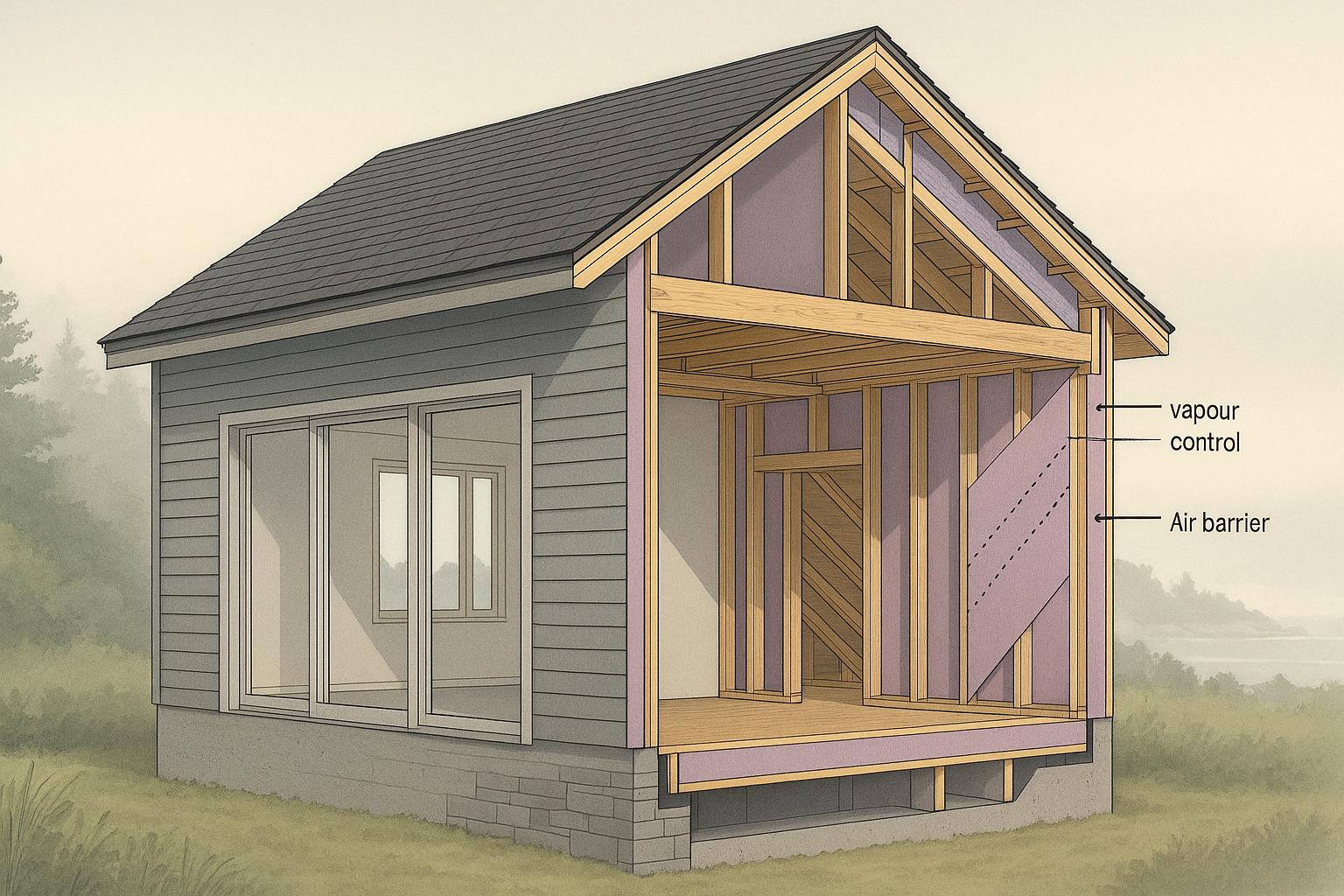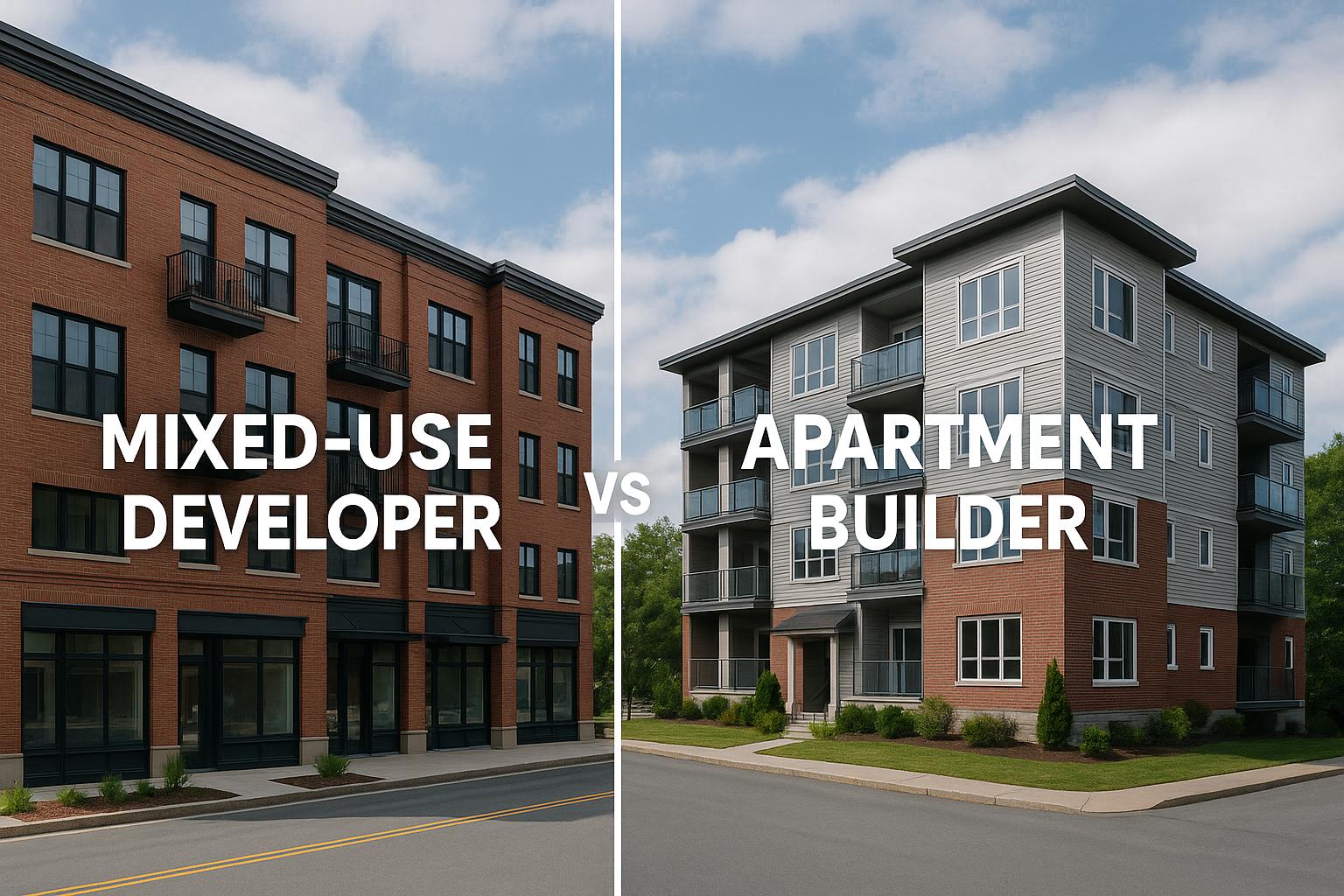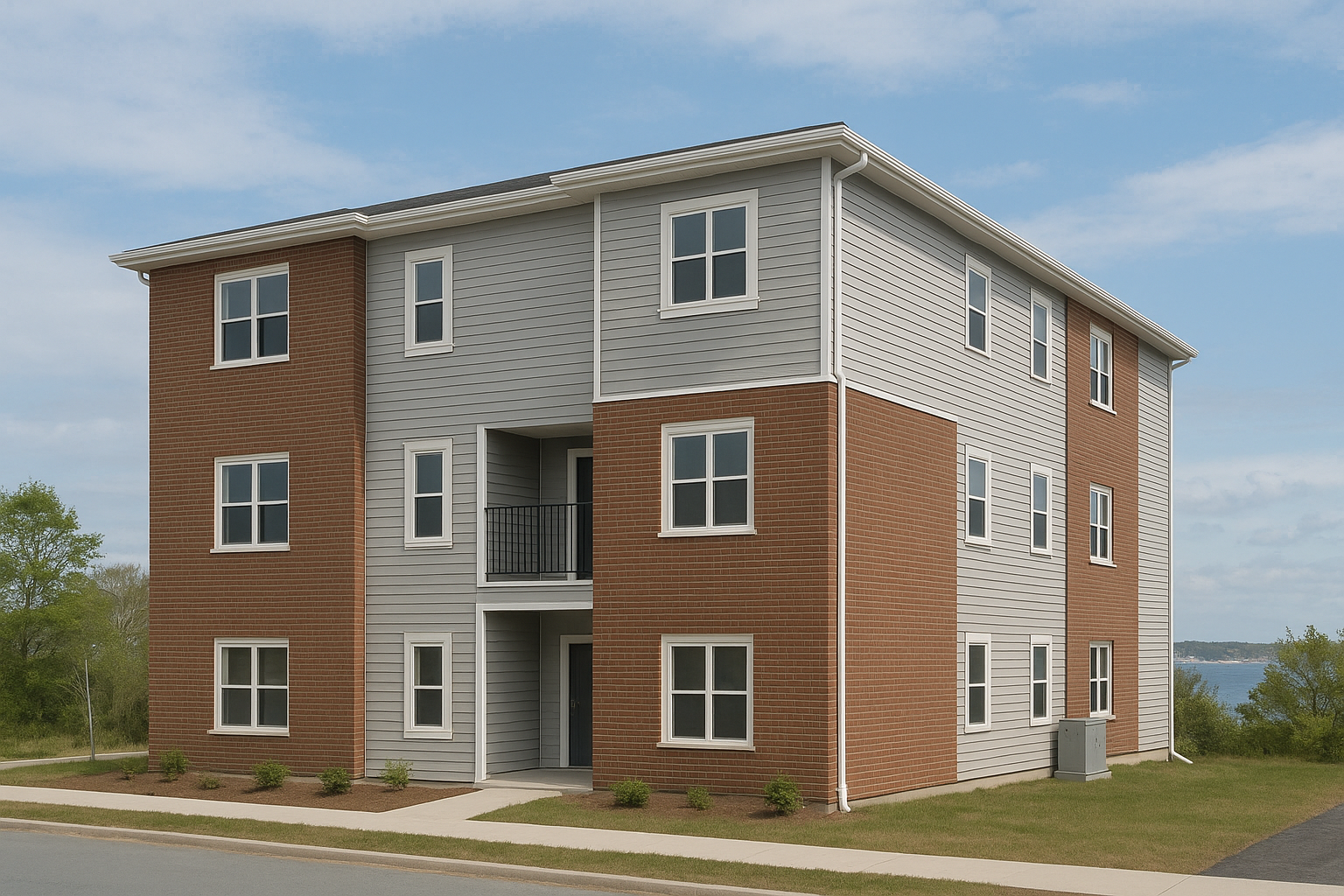Where you build in Nova Scotia directly affects your construction costs and potential returns. Urban areas like Halifax come with higher land prices, utility fees, and municipal charges, but they offer strong rental demand and stable returns. In contrast, rural areas provide cheaper land and lower upfront costs, but challenges like limited contractors, higher delivery expenses, and seasonal rental demand can impact your budget and ROI.
Key Takeaways:
- Urban Areas: Higher costs, better infrastructure, steady rental income ($1,950–$2,100/month), and 12–20% ROI.
- Rural Areas: Lower land costs, higher utility setup expenses (wells, septic), and lower rental demand but potentially higher tenant retention.
| Factor | Rural Nova Scotia | Urban Nova Scotia |
|---|---|---|
| Land Costs | Lower | Higher |
| Utility Fees | Well/septic required | ~$5,400/unit |
| Labour Availability | Limited, travel costs apply | Readily available |
| Rental Income | Lower, seasonal fluctuations | $1,950–$2,100/month |
| ROI | Location-dependent | 12–20% annually |
Rural projects are ideal for those with tighter budgets, while urban builds suit investors seeking consistent cash flow. An integrated construction model with fixed pricing ($160,000/unit) can simplify the process in either location.
Unlocking NOVA SCOTIA Housing Growth: Challenges & Solutions
1. Building in Rural Nova Scotia
Rural Nova Scotia offers a mix of opportunities and challenges for construction projects. While building in these areas can be more affordable in certain respects, there are unique factors that require careful planning. Below, we break down some key cost considerations for rural construction projects.
Land Costs
One of the biggest advantages of building in rural Nova Scotia is the relatively low cost of land. Over the past 30 years, land prices in the province have grown at an average rate of just 3.7% per year, the lowest among all Canadian provinces [1]. However, rural land often needs extra preparation before construction can begin. Tasks like grading, removing trees, and conducting soil tests can add to your overall budget, so it’s essential to account for these expenses early on.
Utility Connections and Fees
Connecting utilities in rural areas can be more complex than in urban settings. Municipal water and sewer services are often unavailable, meaning you’ll likely need to install a well and septic system. Electrical connections can also be tricky, as they may require longer runs from the nearest transformer. Similarly, access to telecommunications services might require special arrangements. Natural gas is rarely an option in rural Nova Scotia, so alternative heating systems like heat pumps or propane tanks are commonly used.
Labour and Materials
Labour and material costs can be higher in rural areas due to additional travel and delivery expenses. Contractors may charge more to cover travel time or accommodation, and material suppliers often add surcharges for delivering to remote locations. Weather conditions, especially during the winter months, can also cause delays and impact project schedules. On the upside, many rural contractors provide personalized service and flexible timelines, which can help balance out some of these challenges.
Rental Market Demand and ROI
The rental market in rural Nova Scotia operates differently than in urban areas. While rental rates are generally lower, property owners often benefit from higher tenant retention and reduced vacancy rates. The key to success in these markets is choosing locations near employment hubs, such as government offices, healthcare facilities, and regional businesses, where demand for rentals tends to be steady. With thoughtful planning and a focus on local market needs, rural properties can deliver strong returns in these less saturated markets.
2. Building in Urban Nova Scotia
Developing in Halifax and its surrounding urban areas comes with higher costs but also offers the benefits of established infrastructure and strong market demand. Here's a closer look at land costs, utility fees, labour, and rental returns in urban Nova Scotia.
Land Costs
Land in urban Nova Scotia, particularly in Halifax and nearby municipalities, is significantly more expensive than in rural regions. The higher price tag reflects the advantages of being close to employment hubs, universities, and well-developed infrastructure. However, zoning regulations and municipal requirements can add complexity to land acquisition. The premium cost is a trade-off for the accessibility to urban amenities and the consistent rental demand that these areas provide.
Utility Connections and Fees
Connecting to utilities in urban areas comes with upfront costs that are generally less common in rural developments. For instance, Halifax Water charges $5,405.81 per unit for new multi-unit dwellings. This includes $4,115.04 for wastewater and $1,290.77 for water connections [3]. Additional municipal fees include $25 per unit for plumbing permits and $248.29 per unit for solid waste charges [3].
Inspection fees further add to the expenses. Halifax Water charges $150 per site visit for water, wastewater, and stormwater service connections, as well as for backflow prevention devices and driveway culverts [3]. Tapping into water services costs $375 for connections up to 75mm, with an extra $125 for every additional 25mm [3].
Electrical connections in urban areas are relatively affordable. Nova Scotia Power charges $11 for standard connections and $46 for on-site service connections without smart meters [2]. The immediate availability of reliable electrical infrastructure in urban areas helps avoid the lengthy installations often required in rural settings.
Labour and Materials
Urban projects benefit from a more concentrated labour force and shorter delivery times for materials. Contractors in Halifax face reduced travel times, which can lead to more competitive pricing. Local material suppliers with distribution centres in the area help cut down on costly long-distance delivery fees. Additionally, the competitive environment ensures multiple qualified contractors are available to bid on projects. Urban areas also have easy access to specialized trades such as plumbers, electricians, and HVAC technicians, which can help speed up construction. Better-maintained roads and proximity to suppliers also mean fewer weather-related delays compared to rural projects.
Rental Market Demand and ROI
Urban rental markets in Nova Scotia, particularly in Halifax, tend to command higher rents and experience more stable demand than rural areas. For example, well-constructed multi-unit properties in the Halifax area often generate monthly rents between $1,950 and $2,100 for two-bedroom units. These higher rental prices, combined with low vacancy rates driven by steady population growth and strong local employment, can help offset the higher construction costs. Urban projects in the region typically deliver an annual ROI of 12–20%. These factors highlight the balance between costs and benefits in urban development, setting the stage for further analysis in the next section.
sbb-itb-16b8a48
Pros and Cons
When deciding between rural and urban development in Nova Scotia, it's essential to consider how location influences both construction costs and potential returns. Each setting comes with its own set of advantages and challenges that can shape your budget and long-term outcomes.
Rural development is appealing due to its lower land costs and minimal utility fees compared to urban areas, where utility connections can cost around $5,400 per unit. Rural projects often face fewer municipal development charges and less stringent regulatory hurdles. However, there are logistical hurdles to keep in mind. Labour shortages can be a common issue, with contractors sometimes charging extra to cover travel or needing accommodations for extended projects. Additionally, rental income in rural areas tends to be lower, with greater seasonal fluctuations in demand.
Urban development, particularly in hubs like Halifax, benefits from established infrastructure and steady market demand. Access to a larger, skilled labour pool reduces travel-related expenses and ensures availability of specialized trades. Proximity to suppliers also helps keep delivery costs down and minimizes weather-related delays. Urban rental markets are stronger, with two-bedroom units typically renting for $1,950 to $2,100 per month, and annual returns on investment (ROI) ranging from 12–20%.
That said, urban projects come with higher upfront costs. Land acquisition requires more capital, and mandatory utility connections add substantial expenses on a per-unit basis. Stricter zoning laws and complex municipal requirements can also lead to approval delays, increasing project timelines.
| Factor | Rural Nova Scotia | Urban Nova Scotia |
|---|---|---|
| Land Costs | Lower | Higher |
| Utility Connection Fees | Minimal to none | Approximately $5,400 per unit |
| Labour Availability | Limited; may incur travel costs | More readily available |
| Material Delivery | Higher costs, possible delays | Lower costs, more reliable delivery |
| Rental Income Potential | Lower average rents | $1,950–$2,100/month for two-bedroom units |
| Vacancy Risk | Greater seasonal variation | Stable rental demand |
| ROI Potential | Can be favourable with strong occupancy | 12–20% annually |
Ultimately, the choice depends on your financial resources and risk tolerance. Rural development is ideal for those looking to keep initial costs low, while urban projects are better suited for investors seeking consistent returns in a well-established market.
To simplify the process, consider an integrated, fixed-price model of $160,000 per unit, which can help streamline coordination and reduce budget uncertainty - whether you're building in the Annapolis Valley or downtown Halifax.
Conclusion
Rural areas offer lower entry costs, while urban spaces promise steadier returns. If you're working with a tight budget, rural projects can be appealing due to the significant savings on land acquisition. On the other hand, urban developments in cities like Halifax provide access to stronger rental markets and more consistent returns.
Beyond location, the construction approach you choose can greatly impact your project's success. Traditional, fragmented construction methods often lead to challenges like coordination issues, budget overruns, and delays. In contrast, an integrated construction model simplifies the process. With fixed-price units at $160,000 and a six-month guaranteed timeline, this method combines planning, engineering, and building under one team. This approach reduces risks, eliminates the hassle of juggling multiple contracts, and ensures financial predictability - whether your project is in the Annapolis Valley or downtown Halifax.
Ultimately, your decision between rural and urban development should reflect your budget, risk tolerance, and investment goals. Rural projects are ideal for those seeking lower initial costs, while urban developments are better suited for investors who value stable cash flow and market reliability. Regardless of your choice, working with an integrated construction team ensures your project stays on track, both financially and on schedule, setting you up for success no matter the location.
FAQs
What factors should you consider when building in rural vs. urban areas of Nova Scotia?
When considering where to build in Nova Scotia, land costs are an important factor to weigh. In rural areas, land is often more affordable, which can help lower your initial investment. However, keep in mind that infrastructure costs - like connecting to utilities - tend to be higher in these regions due to less developed networks. On the other hand, urban centres such as Halifax usually offer better infrastructure access, but the trade-off comes with steeper land prices.
Labour availability is another key consideration. Urban areas generally have a larger workforce to draw from, although wages are often higher. In contrast, rural areas might face challenges with labour shortages, which could lead to delays in your project timeline. Climate and weather conditions also come into play. Coastal rural locations may experience tougher weather, potentially increasing construction costs and causing delays. Meanwhile, building in urban areas might mean dealing with longer permit processing times and higher fees.
By carefully evaluating these factors - land prices, infrastructure, labour availability, and climate - you can make a decision that aligns with your budget and project objectives.
What are the benefits of using an integrated construction model with fixed pricing for building in rural and urban Nova Scotia?
An integrated construction model with fixed pricing brings clear benefits to projects across Nova Scotia, whether in bustling urban centres or quieter rural areas. This approach ensures cost predictability, helping property owners avoid surprise expenses and stick to their budgets. Additionally, it offers a single point of accountability, which simplifies communication and minimizes delays - a crucial advantage in regions where labour availability or utility connection fees can vary.
By tackling challenges unique to specific locations, such as municipal development charges or weather-related issues, this model makes the construction process much smoother. Whether you're building in Halifax, the Valley, or along the coast, this approach supports consistent outcomes and helps property owners better manage their investments.
What are the key risks and benefits of building rental properties in rural versus urban areas of Nova Scotia?
Building rental properties in rural Nova Scotia often comes with the advantage of lower land prices and less competition, making it a more cost-effective option. That said, these areas can present challenges, such as limited tenant demand and occasional dips in occupancy rates. On the bright side, the growing popularity of remote work has sparked increased interest in rural living, which could lead to a steady rise in rental demand over time.
In contrast, urban centres like Halifax provide a more predictable rental market. Here, you’re likely to benefit from consistent tenant demand, reliable rental income, and stronger potential for property value growth. Of course, these perks come at a price - higher land costs, stiffer competition, and potentially more expensive construction. Balancing these pros and cons with your investment objectives is key to deciding which location aligns best with your plans.



